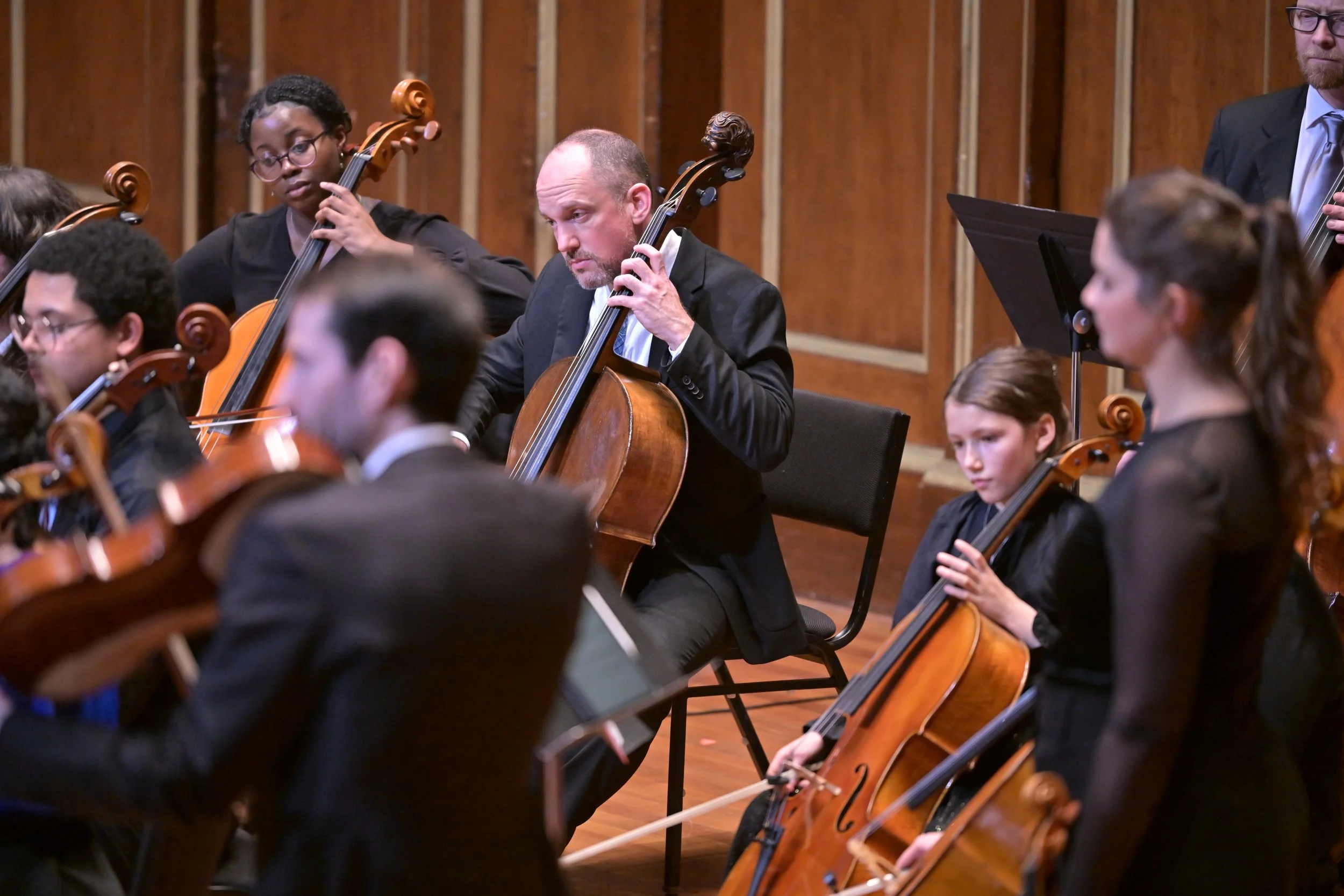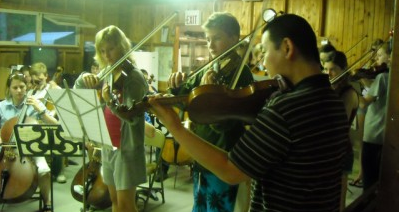Years ago, I'm sitting in a car with a group of people, headingsomewhere - a music festival? A bassist is driving the car, I think.
We are having a great time listening to Bela Fleck when the driver
decides that it is time to turn things up a notch.
"Listen to this," he says, puts in a Kronos Quartet CD, and punches a
track number.
Fistfuls of notes start bouncing around the car at lightning speed,
followed by one of the most stunningly "alive" melodies I've
encountered. Paired with an amazing groove in the rhythm section,
which must have included one certifiably insane dulcimer player, this
song takes off like nothing I'd ever heard. I love to exaggerate, but
that statement is 100 percent bona fide - and the energy created by
this CD track is wild, whirling, and totally wonderful. Perhaps that's
why I neglect to catch its name at the time.
Fast-forward a good bit and suddenly it's 2008 and one of the other
Criers is mentioning to me that there's this great tune out there that
Jesse got to know during a Silk Road workshop at Carnegie. The thought
is to ask someone named - who was it? - Zhurbin - if he'd be willing
to make us an arrangement.
"Wait a second," I say - "Lev Zhurbin? You mean, Ljova?"
And suddenly, things are rewinding again, back to my first moments in
the now-long-silent Wild Ginger Philharmonic, playing in a viola
section led by a guy named Lev who seems too have much energy for any
single musical phrase, who seems to want to play them all at once...
followed by stints out in front of New York restaurants with my new
friend, improv-ing fiddle-style on two violas... and moments like the
one in that Village place where the performer we had come to hear was
late - so Ljova borrowed my viola, strolled on stage, and proceeded to
steal the show by improvising out of thin air until the other
musicians arrived... followed by my then-bemusement as this inspiring
musician busted out of Juilliard and the status quo, left it all
behind, and started doing things his own way for good.
I'd tell Lev about rehearsing Brahms, or maybe it was Bruckner or
Bartok. How great it was.
"Well..." he'd say, "today I wrote a Mexican tune and I think it
sounds kinda Mexican."
Anyone who wants to know how this particular story ends only has to
glance at Ljova's website, www.ljova.com.
Do it. It's inspiring.
So (the present interjects) before I know it, I'm emailing my old
friend to ask about the possibility of arranging this unknown tune
with a weird name. I'm happy to be doing it. Even though I have no
idea about this music, I trust all the players in this situation
absolutely. Jesse wouldn't be excited about this piece unless it was
going to rock the proverbial house, and Ljova wouldn't take something
like this on without making it shine.
It's 11:30 PM (or is it 12:30?), mid-December, and Lev and his wife
Inna (amazing singer-by-night, lawyer-by-day... whew!) and I are at a
friend's house in Boston. We're listening to a reedy MIDI playthrough
of the Silk Road arrangement of this piece and watching the score
pages autoscroll by. Somehow, the pipa line needs to get shared out
between the string sections, he says. My tired head nods. "But I can't
do it right now - the Latin Grammys are coming up in days."
Well, the Latin Grammys came and went, and one fine day, a gorgeous
stack of PDFs of "Turceasca" landed in my inbox.
Curiously, it was just a couple days before that that the Great
Revelation had finally struck me. Lev had mentioned that he needed to
run the parts by Osvaldo Golijov, because the original arrangement had
been the one that Golijov had made for the Kronos Quartet. That moment
of wondering "could it be the same piece?" followed by the wonderful
shock of recognition left me immensely eager to finally get out there
are discover what this nifty, nutty, tune was REALLY all about.
So, I finally started doing my homework! Check this out.
Taraf De Haidouks
Still breathing?
Welcome to the world of the Taraf de Haiidouks, the Romanian gypsy
band that lights a fire under everything that they do, and for whom
their composition "Turceasca" is their official calling card. There is
a wealth of great material from them available on the Internet,
especially via YouTube, and I'd especially recommend one fantastic
video that shows them making music with an entire village, leading
children out of houses Pied-Piper style and trading phrases with the
local musicians. I don't know the link, but it's just as well - the
seach will be rewarding! Or perhaps Sharon, who showed it to me, will
be so kind as to post it...
Also potentially of interest is this link to a great little folk
dancing sheet that details precisely what kind of a dance the
"turceasca" is - "arms free and active, mostly in front of the body,
hands at shoulder level, elbows slightly bent - steps generally small
- usually the hips sway with each step touch..."
Here's the whole link:
Dance the Turceasca (pdf link)
(Anyone want to volunteer to lead the dancing tonight?)
In a way, I wish my dear friend Lev Zhurbin was up here to hear the
fruits of his labors, not just because it would be great to play
Turcaesca for him, but because he could be the one to get people up
out of their seats and show them how to enjoy themselves in motion. As
proof, I offer you one of the sweetest videos I've ever seen - his
wedding procession/dance through the streets of New York City. Old
world, New World, different souls, same spirit.
Ljova's Wedding Procession
There's so much to write about this piece, and the weird confluence of
different situations and relationships that helped to generate
tonight's performance. In a way, it's a metaphor for what we're
navigating in the entire program! But I'll let you go now, with one
final wacky thought.
When Ljova first sent up the PDFs, he sent a MIDI file of the new
arrangement with them. Of course, the sound is horrible and there's no
sense of rubato, no energy, no nuthin.' All the same, I've gotten
strangely addicted to it. It's great to hear the Taraf de Haiidouks
and their effortless virtuosity. It's great to hear the Kronos Quartet
sweating away. But there's something weirdly wonderful about listening
to this silly midi file, because it leaves all the doors wide open. No
decisions have been made, no opinions stamped. Everything is still
possible. In its squat package of sound, I feel like I can hear what
may happen tonight, what may happen on Sunday, and what may happen at
any point in the future.
It's exciting!





 I think most of the kids at PCP really enjoyed the presentation. Quite frankly I was a little daunted having to lead a performance portion after the talk for these 50 or so youngsters, as more than half of them were sight reading the pieces I had brought with me. However to my surprise, they did so well!! A lot of them were able to follow the more complicated directions of dynamics & phrasings of these pieces by the 2nd and 3rd reading as I was thoroughly impressed. I spent my free time during these couple of days kayaking & swimming around Lake Dunmore & making new friends with the faculty and staff at PCP. It's nice to inspire young and raw talent, as I remember when I was at their stage, how much I was ready to soak in the great music & experiences that would come my way. And I have to say that I'm gladly and consistently surprised that so many kids I encounter are not only interested in classical music but have a genuine appreciation for it...It really is exciting to see. At our concerts, we definitely see a few more youngsters than some of the other venues around town, but still the majority of our loyal fans are the mature audiences. So I'm even more excited to have met these kids and plant the seed. I hope they tell all their friends, their siblings, cousins and their teachers at school and will come see one of our Jordan Hall concerts this next season.
I think most of the kids at PCP really enjoyed the presentation. Quite frankly I was a little daunted having to lead a performance portion after the talk for these 50 or so youngsters, as more than half of them were sight reading the pieces I had brought with me. However to my surprise, they did so well!! A lot of them were able to follow the more complicated directions of dynamics & phrasings of these pieces by the 2nd and 3rd reading as I was thoroughly impressed. I spent my free time during these couple of days kayaking & swimming around Lake Dunmore & making new friends with the faculty and staff at PCP. It's nice to inspire young and raw talent, as I remember when I was at their stage, how much I was ready to soak in the great music & experiences that would come my way. And I have to say that I'm gladly and consistently surprised that so many kids I encounter are not only interested in classical music but have a genuine appreciation for it...It really is exciting to see. At our concerts, we definitely see a few more youngsters than some of the other venues around town, but still the majority of our loyal fans are the mature audiences. So I'm even more excited to have met these kids and plant the seed. I hope they tell all their friends, their siblings, cousins and their teachers at school and will come see one of our Jordan Hall concerts this next season. 






